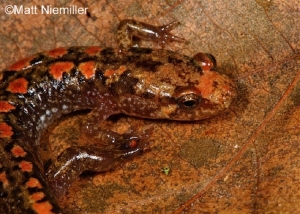Carolina Mountain Dusky Salamander
One of five species formerly lumped together and called the Mountain Dusky Salamander, the Carolina Mountain Dusky Salamander is best told from its near relatives by its range. It is found midway along the Tennessee-North Carolina border. Coloration in this species (2.5 to 4.5 inches in length) is highly variable. They have a round tail and a light line from the eye to the angle of the jaw. Some individuals may have a stripe down the back that can vary in color from yellow to orange, red, or brown. This stripe can be irregular or straight. Other individuals may have spotting or flecking on the back instead of a dorsal stripe, and others, especially males, may be dark with little or no patterning. Some individuals may exhibit red legs or cheek patches.
Similar Species: Separated from the Ocoee Salamander, the Blue Ridge Dusky Salamander, the Allegheny Mountain Dusky Salamander, and the Cumberland Dusky Salamander by its range and by genetic comparison.
Habitat: Typically found along streams, in seepage areas, and on wet rock faces. Some may be encountered far from water; those at higher elevations tend to be more terrestrial than those found at lower levels.
Diet: Forest floor invertebrates make up this species' diet.
Breeding information: Females deposit their eggs under moss, rocks, or logs, or under logs in or near flowing water. The female remains with her eggs until they hatch. Hatchling salamanders emerge from their eggs with external gills and spend up to 10 months as fully aquatic larvae before transforming into adults.
Status in Tennessee: Very common within its limited range.
Fun Facts:
- The Carolina Mountain Dusky Salamander can be the most abundant salamander in its range. Some population counts have yielded densities of more than 2,500 individuals per acre
- Active primarily at night
Best places to see in Tennessee: Found midway along the mountainous border with North Carolina.

